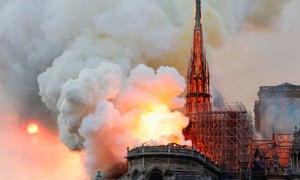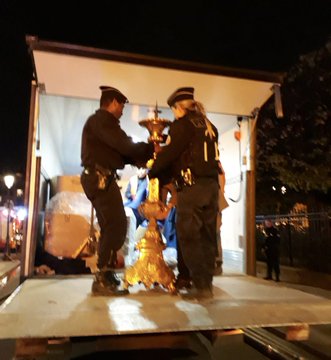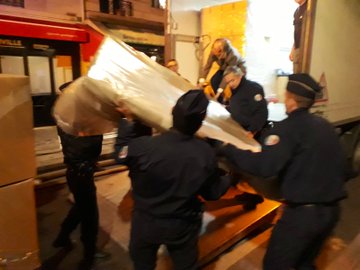Tue 16 Apr 2019:
Fire brought under control on Tuesday but spire of centuries-old landmark destroyed after flames burst through the roof
A fire that devastated Notre Dame Cathedral in the heart of Paris was brought under control by firefighters in the early hours of Tuesday morning, though officials warned there were still residual fires to put out.
Thousands of Parisians watched in horror from behind police cordons as a ferocious blaze devastated Notre Dame Cathedral on Monday night, destroying its spire and a large part of the roof.
An investigation has been opened by the prosecutor’s office, but police said it began accidentally and may be linked to building work at the cathedral. The 850-year-old gothic masterpiece had been undergoing restoration work.
Macron said “the worst had been avoided” thanks to hundreds of brave firefighters who battled for hours and who would continue working through the night. One firefighter was severely injured but no other casualties were reported.
“What happened tonight in Paris, in this cathedral, is a terrible event,” the president said, vowing to raise funds worldwide and bring the best talents from around the world to reconstruct the building in its entirety.
“Notre Dame is our history, our literature, part of our psyche, the place of all our great events, our epidemics, our wars, our liberations, the epicentre of our lives … So I solemnly say tonight: we will rebuild it together.”
Macron announced an international fundraising campaign to raise money for the repairs. French billionaire François-Henri Pinault, the chairman and CEO of international luxury group Kering, pledged 100 million euros towards rebuilding Notre Dame.
Laurent Nunez, junior minister of the interior said on Tuesday: “Now the fire danger has been dealt with, there is the issue of the building and whether the structure has resisted the very serious fire. A meeting of experts and national architects is taking place this morning to consider whether the building is stable and whether fire-officers can set up inside to continue their work.”
Franck Riester, the culture minister, said the situation was still precarious but he was hopeful. “We’re optimistic because the two belfries were saved.”
He said it was too early to determine exactly which pieces of priceless art were damaged, saying the organ had been affected and paintings may have suffered from water damage.
Thousands of Parisians – many weeping and some praying – watched as vast orange flames soared from the roof for hours, threatening one of the greatest architectural treasures of the western world. There were gasps on the southern bank of the river Seine as locals watched fire sweep across the roof, which slowly caved in.

The 12th-century cathedral is home to priceless works of art and is one of the world’s most famous tourist attractions, immortalised in Victor Hugo’s 1831 novel The Hunchback of Notre Dame. It attracts about 13 million visitors a year from around the world.
“We consider the two towers of Notre Dame to have been saved,” the Paris fire-service commander Jean-Claude Galler said at around 11pm, as firefighters were still working to contain flames. The fire service said the fire had been reduced and it was a major accomplishment by hundreds of firefighters that the flames were stopped from spreading to the north tower belfry. However, the roof “had been ravaged”, with around two thirds destroyed.
Fire brigade officers, who were preparing to spend the night attempting to cool the building, said the structure of the cathedral was “saved and preserved”. A spokesman said there was still a risk that scaffolding in the heart of the building could collapse.
By 7pm, flames had burst through the roof of the cathedral and quickly engulfed the lead and wood structure of the cathedral’s spire, which collapsed.

The spire had been added to the building in the 19th century. As part of its renovations, several bronze statues that surrounded the spire had been removed.
The wooden frame at the top of the 13th-century landmark was made from so many oak beams that it was known as “the forest”. That wood proved so combustible, the Paris fire service said, that it there was a danger to firefighters.
Smoke billowed into the sky, visible from across the city, and ash fell in the surrounding area.
The mayor of Paris, Anne Hidalgo, said that most artworks and religious relics were removed from Notre Dame as firefighters worked to control the blaze.
France’s culture minister, Franck Riester, posted photos on social media of people loading art on to trucks.
On the left bank of the river Seine, thousands of onlookers gathered at police cordons watching as the flames burned high into the clear blue sky. As part of the roof gradually collapsed in flames, bangs and crackles could be heard from the street. Some people sang Catholic liturgies as they watched. Others sank to their knees. Many were in tears.
Camille, 20, from Normandy, a history student at the Sorbonne, watched as flames blazed through the frame of one of the cathedral’s smaller stained glass windows. “There’s a feeling of total sadness and also anger,” she said. “It’s our heritage. Whether you’re Christian or not, part of our history is going up in smoke.”
Alexis, 35, a finance worker, had hurried to the scene after seeing the first images on the television news. “I rushed down. I never thought it would be this depressing,” he said. Over the course of an hour, he watched as the flames spread across the roof and sections of it slowly collapsed.
A 55-year-old furniture restorer, who did not wish to give his name, said: “This is a major moment,” he said. “This building is a symbol of Catholicism. It’s a symbol of Paris.”
On the north side of the cathedral on the Île Saint-Louis, more crowds had gathered. “It’s a national tragedy,” said Paul Rechter, who lives barely 100 metres from the cathedral. “It’s a symbol of France that is collapsing there, part of our national identity going up in smoke. Part of our history, our culture, our literature … How on earth could it have happened? Why were there no precautions?”
Pierre Mesnage, 44, who has lived on the Île de la Cité for the past 20 years in an apartment that overlooks the cathedral, said: “I cried when I saw it, honestly. I wept. I see that building every single day, all day if I’m at home. It’s a drama. A personal and a national tragedy. I’m a Catholic, too, so there’s an added significance. I really don’t understand how it could happen. This is an emblem of Paris, an emblem of France. Why wasn’t it protected?”
Ruud van der Leij, a computer studies teacher from Rotterdam, said he had been staring at the flames for more than two hours. “You can’t look away,” he said. “It’s awful and fascinating at the same time. A terrible, awful, sad affair. Such a symbol.”
Marina Valleix, 42, said she had come specially from her home in the 19th arrondissement of Paris. “I do treasure hunts with clues, for children, round the big Paris monuments,” she said. “I’m here more or less every weekend. I had to come and see.”
The disaster “has got to me, definitely”, she said. “I’m confident it will be rebuilt, and I know Notre Dame has already burned, the spire has already fallen in the past. I know we can and will rebuild. But still, it’s sad. To see it like this, it’s terribly sad.”







